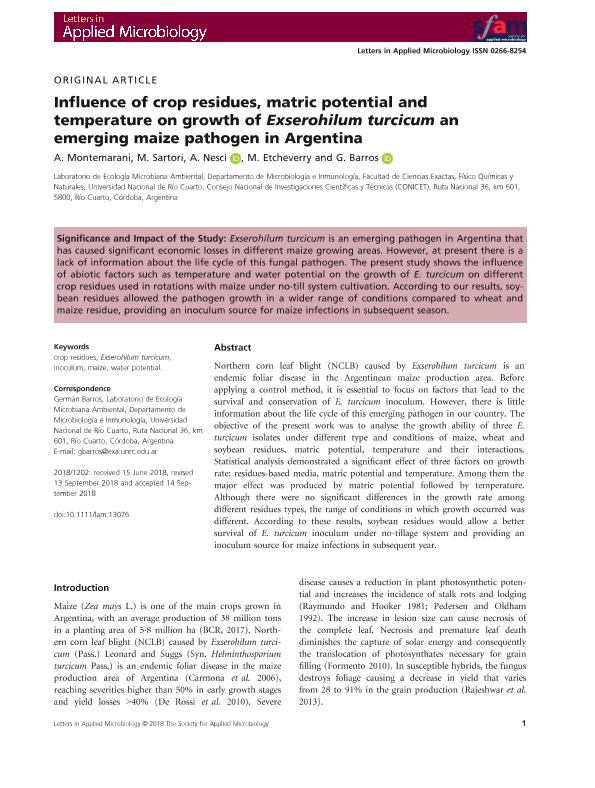Mostrar el registro sencillo del ítem
dc.contributor.author
Montemarani, Analía Mariana

dc.contributor.author
Sartori, Melina Victoria

dc.contributor.author
Nesci, Andrea Verónica

dc.contributor.author
Etcheverry, Miriam Graciela

dc.contributor.author
Barros, Germán Gustavo

dc.date.available
2021-02-05T17:25:30Z
dc.date.issued
2018-12
dc.identifier.citation
Montemarani, Analía Mariana; Sartori, Melina Victoria; Nesci, Andrea Verónica; Etcheverry, Miriam Graciela; Barros, Germán Gustavo; Influence of crop residues, matric potential and temperature on growth of Exserohilum turcicum an emerging maize pathogen in Argentina; Wiley Blackwell Publishing, Inc; Letters in Applied Microbiology; 67; 6; 12-2018; 614-619
dc.identifier.issn
0266-8254
dc.identifier.uri
http://hdl.handle.net/11336/124956
dc.description.abstract
Northern corn leaf blight (NCLB) caused by Exserohilum turcicum is an endemic foliar disease in the Argentinean maize production area. Before applying a control method, it is essential to focus on factors that lead to the survival and conservation of E. turcicum inoculum. However, there is little information about the life cycle of this emerging pathogen in our country. The objective of the present work was to analyse the growth ability of three E. turcicum isolates under different type and conditions of maize, wheat and soybean residues, matric potential, temperature and their interactions. Statistical analysis demonstrated a significant effect of three factors on growth rate: residues-based media, matric potential and temperature. Among them the major effect was produced by matric potential followed by temperature. Although there were no significant differences in the growth rate among different residues types, the range of conditions in which growth occurred was different. According to these results, soybean residues would allow a better survival of E. turcicum inoculum under no-tillage system and providing an inoculum source for maize infections in subsequent year. Significance and Impact of the Study: Exserohilum turcicum is an emerging pathogen in Argentina that has caused significant economic losses in different maize growing areas. However, at present there is a lack of information about the life cycle of this fungal pathogen. The present study shows the influence of abiotic factors such as temperature and water potential on the growth of E. turcicum on different crop residues used in rotations with maize under no-till system cultivation. According to our results, soybean residues allowed the pathogen growth in a wider range of conditions compared to wheat and maize residue, providing an inoculum source for maize infections in subsequent season.
dc.format
application/pdf
dc.language.iso
eng
dc.publisher
Wiley Blackwell Publishing, Inc

dc.rights
info:eu-repo/semantics/openAccess
dc.rights.uri
https://creativecommons.org/licenses/by-nc-sa/2.5/ar/
dc.subject
CROP RESIDUES
dc.subject
EXSEROHILUM TURCICUM
dc.subject
INOCULUM
dc.subject
MAIZE
dc.subject
WATER POTENTIAL
dc.subject.classification
Ecología

dc.subject.classification
Ciencias Biológicas

dc.subject.classification
CIENCIAS NATURALES Y EXACTAS

dc.title
Influence of crop residues, matric potential and temperature on growth of Exserohilum turcicum an emerging maize pathogen in Argentina
dc.type
info:eu-repo/semantics/article
dc.type
info:ar-repo/semantics/artículo
dc.type
info:eu-repo/semantics/publishedVersion
dc.date.updated
2020-12-04T14:45:05Z
dc.identifier.eissn
1472-765X
dc.journal.volume
67
dc.journal.number
6
dc.journal.pagination
614-619
dc.journal.pais
Reino Unido

dc.journal.ciudad
Londres
dc.description.fil
Fil: Montemarani, Analía Mariana. Universidad Nacional de Río Cuarto. Facultad de Ciencias Exactas Fisicoquímicas y Naturales. Instituto de Investigación en Micología y Micotoxicología. - Consejo Nacional de Investigaciones Científicas y Técnicas. Centro Científico Tecnológico Conicet - Córdoba. Instituto de Investigación en Micología y Micotoxicología; Argentina
dc.description.fil
Fil: Sartori, Melina Victoria. Universidad Nacional de Río Cuarto. Facultad de Ciencias Exactas Fisicoquímicas y Naturales. Instituto de Investigación en Micología y Micotoxicología. - Consejo Nacional de Investigaciones Científicas y Técnicas. Centro Científico Tecnológico Conicet - Córdoba. Instituto de Investigación en Micología y Micotoxicología; Argentina
dc.description.fil
Fil: Nesci, Andrea Verónica. Universidad Nacional de Río Cuarto. Facultad de Ciencias Exactas Fisicoquímicas y Naturales. Instituto de Investigación en Micología y Micotoxicología. - Consejo Nacional de Investigaciones Científicas y Técnicas. Centro Científico Tecnológico Conicet - Córdoba. Instituto de Investigación en Micología y Micotoxicología; Argentina
dc.description.fil
Fil: Etcheverry, Miriam Graciela. Universidad Nacional de Río Cuarto. Facultad de Ciencias Exactas Fisicoquímicas y Naturales. Instituto de Investigación en Micología y Micotoxicología. - Consejo Nacional de Investigaciones Científicas y Técnicas. Centro Científico Tecnológico Conicet - Córdoba. Instituto de Investigación en Micología y Micotoxicología; Argentina
dc.description.fil
Fil: Barros, Germán Gustavo. Universidad Nacional de Río Cuarto. Facultad de Ciencias Exactas Fisicoquímicas y Naturales. Instituto de Investigación en Micología y Micotoxicología. - Consejo Nacional de Investigaciones Científicas y Técnicas. Centro Científico Tecnológico Conicet - Córdoba. Instituto de Investigación en Micología y Micotoxicología; Argentina
dc.journal.title
Letters in Applied Microbiology

dc.relation.alternativeid
info:eu-repo/semantics/altIdentifier/doi/http://dx.doi.org/10.1111/lam.13076
dc.relation.alternativeid
info:eu-repo/semantics/altIdentifier/url/https://sfamjournals.onlinelibrary.wiley.com/doi/abs/10.1111/lam.13076
Archivos asociados
